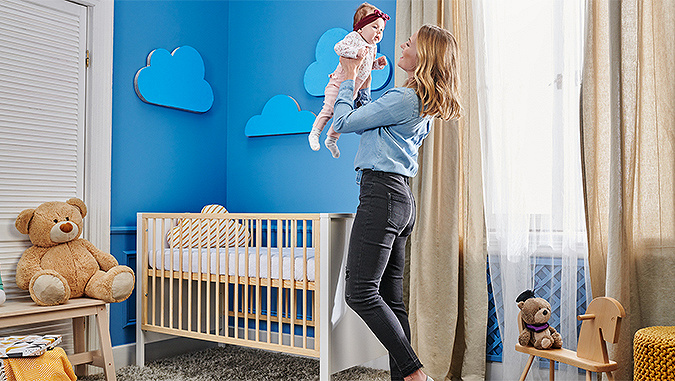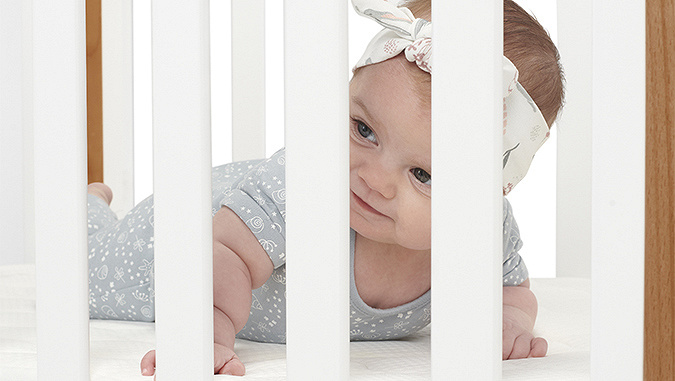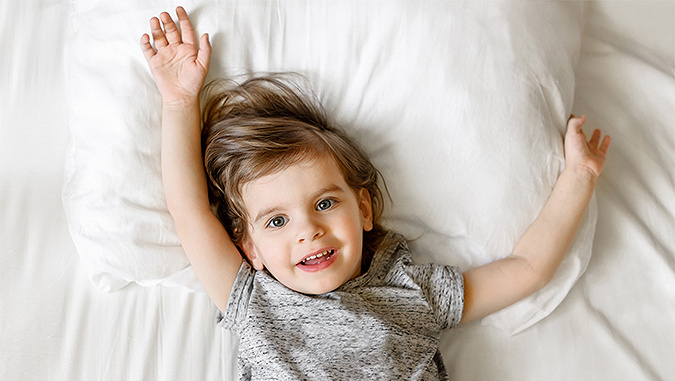Baby cot mattress
8 min

Babies sleep up to 20 hours a day. This is an extremely important time for them as they grow and their body develops. That is why you should take care of the comfort of your child. A properly selected cot mattress will provide it. On the market you will find many models and types - some of them are very different, so it is no wonder that many people do not know which mattress will be the best. What to look for and how to choose the perfect mattress? We give you a hint!
Is a mattress necessary?
When buying a cot for your little one, you need to remember that you generally need to buy a mattress in addition to it. Some manufacturers only sell bare frames. However we know how important it is to choose the right mattress, so we also offer cots with mattresses. This is the case, for example, with the KOYA 4-in-1 cot with non-standard dimensions - thanks to this you can save the time you would need to search for a mattress that is difficult to find. And it is the mattress that determines whether your child will be comfortable and whether their sleep will be healthy. Buying a good product, unfortunately, is not necessarily cheap, but it is worth investing into a mattress of the proper quality - an investment in the health, comfort and convenience of your baby.

What mattress filling to choose for an infant?
On the market you will find many different cot mattresses, differing primarily in fillings. Each of them has different characteristics, different advantages and disadvantages. Also not all of them will be equally beneficial for the development of the baby. So which mattress should you choose? Read our short guide!
Foam mattress
Foam mattresses are very popular among parents looking for the best cot equipment for babies. And basically, this is hardly surprising, as they are actually very good products. The problem is that not every foam mattress is the same. They differ in the type of foam used - the most popular are polyurethane, high-plastic and thermoelastic foams.
Polyurethane foam has the advantage of being cheap (the price of a mattress is about 40-80 zł) and quite breathable. But that's basically where its advantages end. This type of foam is delicate, and therefore easily deforms. With the appearance of indentations and loss of resilience, the child will be less and less comfortable, and what's worse, their spine will be exposed to uneven support. In addition, poorer quality polyurethane foams may cause allergies.
High-plastic polyurethane foam has all the advantages of polyurethane foam (although it is a little more expensive, the price of such a mattress is about 200 zł), and at the same time is devoid of its disadvantages. It is much more durable, resilient and flexible, and it is not allergenic. It is therefore safe for a small spine and for allergy sufferers. From the group of foam mattresses, it is definitely the best choice for a baby.
Thermoelastic foam, on the other hand, is a very good choice, but not necessarily for the smallest children. This type of cot mattress reacts to body heat and adapts to the body shape. Infants, on the other hand, should sleep on slightly firmer mattresses until they are one year old. At the same time, this type of foam accumulates heat, so it may affect the overheating of the small body.
Foam mattresses are often found in cots that accompany babies for years. An example of such a cot is our MIA cot, which adapts to the child's age. It works well from birth until your child reaches a height of 120 cm, because it easily changes from a cot to a 2-in-1 cot (day bed) for an older child.
Spring mattress
Spring model is another good cot mattress for children - comfortable, non-deforming, durable - but unfortunately, it is not recommended as ideal for the youngest kids. Low weight of a baby can adversely affect the proper work of springs, and thus such a mattress incorrectly supports the delicate spine of the baby.
Latex mattress
Latex mattresses are considered some of the best on the market - even for babies. They are flexible, durable, do not heat up under the influence of body heat, and have very good support points. Their only imperfection is the - admittedly small, but existing - it’s a chance that they will be allergenic. But this is a problem only for mattresses with natural latex, which is made from rubber milk containing protein. In the case of synthetic latex this problem disappears - mattresses created on its basis are antibacterial and anti-allergenic, but slightly less breathable than natural ones.
Coconut-buckwheat mattress
The coconut-buckwheat mattress is a product made of completely natural materials, consisting of two layers: coconut and buckwheat. The coconut layer has a high level of hardness due to fibres from the coconut shell, and is therefore better suited to babies. The buckwheat layer, on the other hand, adapts better to the body - so this side should be slept on when the child grows up a bit. Buckwheat additionally does not heat up from the body and provides good ventilation. When you decide on this type of material, it is necessary to pay attention to the certificates confirming that the buckwheat used in the production of the mattress comes from safe crops, where no chemicals were used. This type of cot mattress also has its opponents, who accuse it of being too hard for babies' backs and the possibility of mould growth.
Latex-coconut mattress
This cot mattress is considered to be an improved version of the coconut-buckwheat model, as it has an additional latex layer. Thanks to this, it adapts better to the infant's small body, because latex gives the mattress more softness and flexibility. At the same time the mattress does not deform and is resistant to moisture. Remember, however, that the baby should be laid on the latex part of the mattress.
Other combination mattresses
There are many more types of combination mattresses on the market. You can find foam and coconut mattresses and foam and buckwheat mattresses, combining coconut with foam or buckwheat alone. You'll even find more unusual materials, like sea grass or horsehair. Each of them has as many supporters as opponents. Natural materials may not cope well with humidity and may be more allergenic. It is also more difficult to keep them clean, as they usually cannot be washed.

Firm or soft? What kind of mattress for my child?
One feature that distinguishes mattresses from each other is the firmness level. When shopping for the perfect mattress for your baby’s cot, sooner or later the moment comes to ask the question: is it better to bet on a firm or soft mattress? Each mattress has its advantages and disadvantages, so neither is ideal. So it's best to opt for something in between.
A cor mattress that is too soft can cause your baby to collapse and make movement difficult. A mattress that is too firm may simply be uncomfortable. A medium-firm mattress should provide good support for the spine and be flexible enough to adapt to the body's position.
If you look for the rule of thumb for choosing the right firmness of a cot mattress, it should vary based on the age of the baby. Until the age of one year, your child should sleep on a slightly firmer mattress. After that, however, you can opt for a slightly softer variant. On the market you can even find mattresses with two levels of firmness, which you can simply reverse after one year.
Because of the need to support small spines of infants, our extensions - NESTE UP or UNO UP - are equipped with firmer mattresses, exactly the kind recommended by physiotherapists for babies up to 9 kg.
Safety - certificates
Safety in mattresses is ensured primarily by the quality of the materials used. They should be non-toxic, non-allergenic, harmless, preventing the development of fungi, dust mites and other allergens. How can you be sure that the mattress you are interested in is of the right quality? Appropriate certificates will inform you about that.
The basic certification for all products intended for children and mothers, including mattresses, is the Positive Opinion of the Institute of Mother and Child. This institute checks whether all materials used to create the product are safe. A similar task has the National Institute of Hygiene, which controls the composition of the product for the presence of harmful substances. An important standard in the European Union is OEKO-TEX Standard 100, checking the quality of textile products for the presence of the 100 most hazardous substances in the material used.
There are many more different types of certifications. Many of them concern quality control of specific materials. For example, the EuroLATEX Eco Standard guarantees the highest quality and safety for latex mattresses. The same is true for the WF4 Dry System certificate, which is a specialized certificate that verifies that the latex has been subjected to an air drying process with varying temperatures. Other certifications specify specific mattress properties. For example, TLS AIR SYSTEM, which certifies proper air circulation.
The best mattress for an allergy sufferer? Latex!
What baby cot mattress to choose if your little one has an allergy problem? There are a few tips that are good to consider. The mattress is a place where microorganisms and fungi can easily multiply. It is also home to a large number of dust mites, and some types of mattresses can also store dust. What type of mattress is best suited for allergy sufferers?
First and foremost, avoid mattresses with natural fillings. Coconut, buckwheat, seagrass, wool or horsehair are a perfect ground for mites and mould to grow and can also lead to problems with moisture accumulation and the proliferation of fungi. A spring mattress is also a bad choice for allergy sufferers, as dust can become a problem in the spaces between the springs.
So what to choose? Hypoallergenic mattresses, namely foam and, above all, latex. They naturally prevent the development of pathogens and microorganisms. And at the same time they are easy to keep clean, thanks to which we avoid the problem with dust. However, some people may be allergic to latex itself - the solution should be an anti-mite cover and a cotton sheet.
